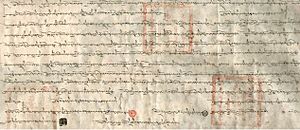Treaty of friendship and alliance between the Government of Mongolia and Tibet facts for kids
In 1913, Tibet and Mongolia signed a special agreement. It was called the Treaty of friendship and alliance between the Government of Mongolia and Tibet. They signed it on February 2, 1913. The signing happened in Urga, which is now Ulaanbaatar. Today, people are not sure if this treaty is still valid.
Contents
Why the Treaty Was Questioned
The Qing Dynasty in China ended in 1911. After this, both Tibet and Mongolia wanted to be independent. Both places had a Buddhist leader. But the Republic of China did not agree. They still thought Tibet and Mongolia were part of China.
In the treaty, Mongolia and Tibet agreed to see each other as independent. They also promised to help each other if there was a war.
Who Signed the Treaty?
For Mongolia, two important people signed. They were foreign minister Da Lama Ravdan and General Manlaibaatar Damdinsüren. For Tibet, three people signed. They were Agvan Dorjiev, Chijamts, and Gendun-Galsan.
However, there were problems with the signatures. Dorjiev was a Buryat person. He was a citizen of Russia. Because of this, some people thought the treaty might not be legal.
The 13th Dalai Lama said he never allowed Dorjiev to sign a treaty. Also, no official from the Tibetan government ever signed it. The Russian government also said Dorjiev was Russian. This meant he could not act as a diplomat for the Dalai Lama.
Why Other Countries Didn't Agree
Most other countries did not see Mongolia or Tibet as independent. They believed these areas belonged to China. Big countries like the United Kingdom and Russia had treaties with the Qing Dynasty. China promised to keep these old agreements.
If these countries recognized Tibet or Mongolia as independent, their old treaties would be broken. The United Kingdom and Russia worried about this. They feared that if Tibet or Mongolia became truly independent, another big country might gain control. They thought it was better for China to control them, because China was not very strong at that time.
What Happened Next
British leaders learned about the treaty at the Simla Convention. They became suspicious. They worried that Russia might use the treaty to get more power in Tibet.
In the end, China did not sign the Simla Convention. Instead, a similar agreement was made later. Mongolia, China, and Russia signed a treaty on May 25, 1915. This was called the tripartite Treaty of Kyakhta.
This new agreement said that Mongolia could manage its own internal matters. It also gave Russia certain special rights in Mongolia. But at the same time, the treaty stated that Mongolia was still a part of China.
See also
 In Spanish: Tratado de amistad y alianza entre el gobierno de Mongolia y el Tíbet para niños
In Spanish: Tratado de amistad y alianza entre el gobierno de Mongolia y el Tíbet para niños


